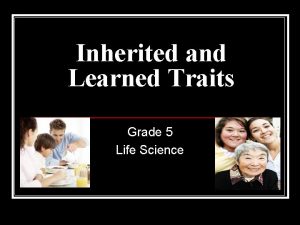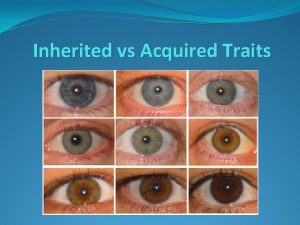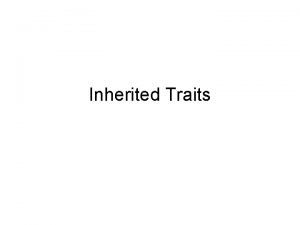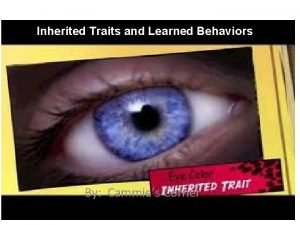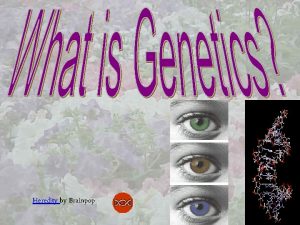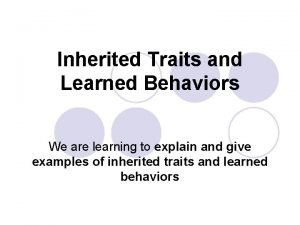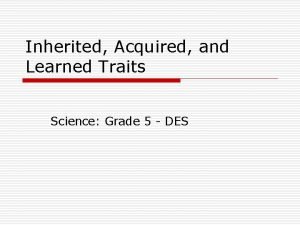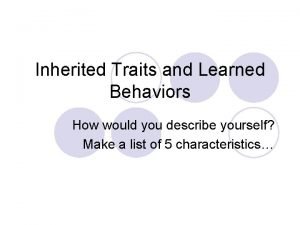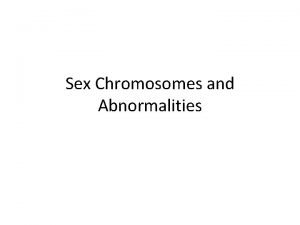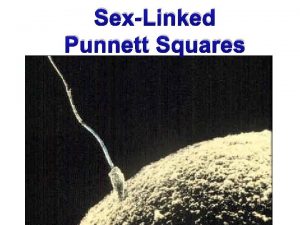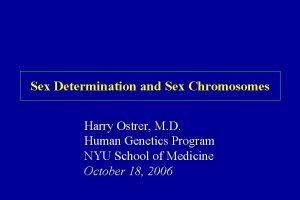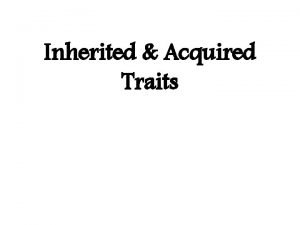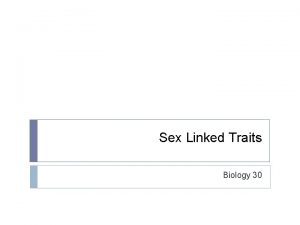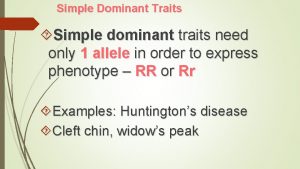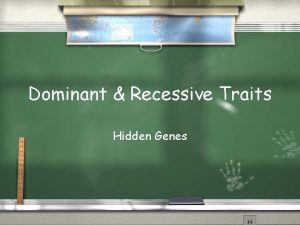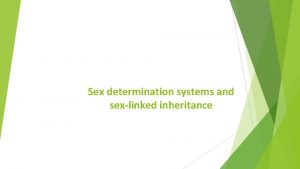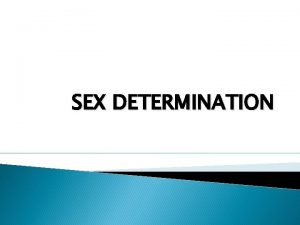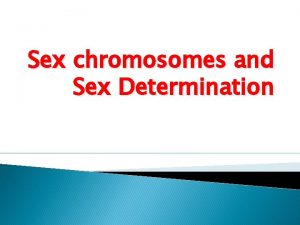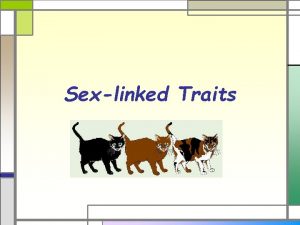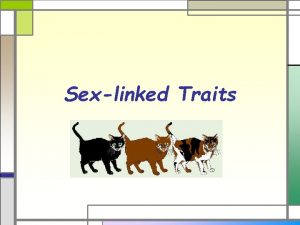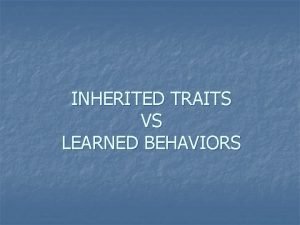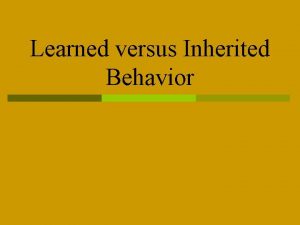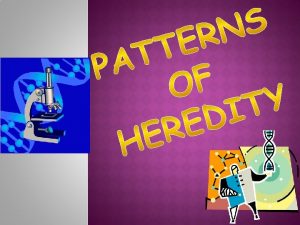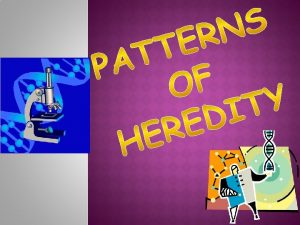Inherited Traits Sex Determination Selected Hereditary Traits Dominant

























- Slides: 25

Inherited Traits & Sex Determination

Selected Hereditary Traits Dominant Recessive Right handedness Left handedness Hair on middle Segment of digits no hair Hitch-hiker’s thumb Normal thumb Polydactylism (extra digits) Normal digits Polydactylism is a dominant trait; a normal number of digits is the recessive condition. Brachydactylism (short Normal digits) Pattern baldness Normal hair Free ear lobes Attached ear lobes In this crowd of men, almost all show some degree of pattern baldness, a dominant trait.

Eye Color Determination of eye color is complex, involving perhaps many genes. Any eye color other than pure blue is determined by a dominant allele that codes for the production of the pigment called melanin. Hazel, green, grey and brown eyes are dominant over blue. Dominant Recessive Phenotype: Brown, green, hazel, or grey Phenotype: Blue Allele: B Allele: b

Human Handedness • The trait of left or right handedness is genetically determined. • Right-handed people have the dominant allele. • People that consider themselves ambidextrous can assume they have the dominant allele for this trait. Dominant Recessive Phenotype: Righthanded Phenotype: Lefthanded Allele: R Allele: r

Human Tongue Roll • The ability to roll the tongue into a U-shape when viewed from the front is controlled by a dominant allele. • There are rare instances where a person can roll it in the opposite direction (to form an n-shape). Dominant Recessive Phenotype: Can roll tongue Phenotype: Cannot roll tongue Allele: T Allele: t

Human Mid-Digit Hair • Some people have a dominant allele that causes hair to grow on the middle segment of their fingers. • It may not be present on all fingers, and in some cases may be very fine and hard to see. Dominant Recessive Phenotype: Hair on mid segment Phenotype: No hair on mid segment Allele: M Allele: m

Thumb Hyperextension • • There is a gene that controls the trait known as hitchhiker's thumb, which is technically termed distal hyperextensibility. People with the dominant phenotype are able to curve their thumb backwards without assistance, so that it forms an arc shape. Dominant Recessive Phenotype: Hitchhikers thumb Phenotype: Normal thumb Allele: H Allele: h

Human Ear Lobe Attachment • • In people with only the recessive allele (homozygous recessive), ear lobes are attached to the side of the face. The presence of a dominant allele causes the ear lobe to hang freely. Dominant Recessive Phenotype: Lobes free Phenotype: Lobes attached Allele: F Allele: f

Other Hereditary Traits Brown eyes are dominant over blue Dark brown hair is dominant over other hair colors Dominant Recessive Curly hair Dark brown hair Straight hair All other colors Coarse body hair Fine body hair Syndactylism (webbed digits) Normal digits Normal skin pigmentation Albinism Brown eyes Blue or grey eyes Near or far-sightedness Normal hearing Normal color vision Broad lips Large eyes Normal vision Deafness Color blindness Thin lips Small eyes Roll tongue into U-shape No tongue roll A or B blood factor O blood factor

Genomic Imprinting Maternal imprint on chromosome in egg The phenotypic effects of some mammalian genes depend on whether they were inherited from the mother or the father. This phenomenon, called genomic imprinting, is part of epigenetics, which looks at the heritable changes in gene function that occur without involving nuclear DNA. Just as cells inherit genes, they also inherit instructions that tell the genes when to become active, in which tissue, and to what extent. Epigenetic phenomena are important because they regulate when and at what level genes are expressed. Paternal imprint on chromosome in sperm Inherited imprinting affects the development of the individual Somatic cells Maternal and paternal chromosomes are differently imprinted. Each generation, chromosomes are newly imprinted.

Imprinted Genes How are imprinted genes different? Paternal chromosome Deletion mutation In some cases, an imprinted gene is activated only if it is inherited from the father; in other cases, only if it comes from the mother. The corresponding allele is inactivated. Evidence of this is seen in two human genetic disorders. Both are caused by the same mutation: a specific deletion of chromosome 15. If the mutation is inherited from the father, the result is Prader-Willi syndrome. If the mutation is inherited from the mother, the result is Angelman syndrome. Maternal chromosome Prader-Willi syndrome Angelman syndrome Mental retardation, obesity, short stature, unusually small hands and feet Uncontrollable laughter, jerky movements, motor and mental abnormalities

Gene Silencing How are genes imprinted? Imprints may act as silencers or activators for imprinted genes. DNA methylation is a well understood example of an imprinting phenomenon. DNA methylation turns off gene expression by establishing a silent chromatin state through the addition of a methyl-group to cytosines in the DNA. This changes the state of the chromatin so that the expression of any genes in the methylated region is inhibited. In this way, either a maternal or paternal gene may be silenced. Methylation is also important in the Xinactivation of chromosomes. Which genes did you inherit from your mother and which from your father? For some genes, imprinting will affect phenotypic expression.

Chromosome Mapping • • Generally, the further apart any two genes are on the same chromosome, the greater the incidence of crossing over between them. By determining crossover frequencies between two genes, their sequence and genetic distance on a chromosome can be established. A Calculation: Using the crossover frequency (COV) between the two genes, the relative position of genes A and B can be represented on a genetic map: 10 map units 22% B By providing cross over frequencies for other combinations of genes, it is possible to create a chromosome map. A map for the following cross over frequencies: A – C = 10%, A – B = 22%, B – C = 12% 12 map units

Genetic Counseling • • • Genetic counseling is an analysis of the risk of producing offspring with known gene defects within a family. People usually consider genetic counseling if they have a family history of a genetic disorder, or if a routine prenatal screening test yields an unexpected result. Counsellors: • • Identify families at risk and investigate the problem present in the family. Interpret information about the disorder. Analyze inheritance patterns and risks of recurrence. Review available options with the family. ?

Genetic Counseling Genetic counseling provides information to families who have members with birth defects or genetic disorders, and to families who may be at risk for a variety of inherited conditions. About half of the cases of childhood deafness are the result of an autosomal recessive disorder. Early identification of the problem allows early appropriate treatment. Pregnant women often have a prenatal test for chromosomal abnormalities such as Down syndrome (trisomy 21) and abnormalities of development such as neural defects.

Identifying Defective Genes • • • Increasingly, there are DNA tests for the identification of specific defective genes. While screening for many genetic disorders is now recommended, the use of pre-symptomatic tests for adult-onset disorders, such as Alzheimer's, is still controversial. Genetic testing may involve: • • • Biochemical tests for gene products such as enzymes and other proteins. Microscopic examination of stained or fluorescent chromosomes. Examination of the DNA itself. Test Explanation Identifying unaffected individuals who carry one copy of a gene for a Carrier screening disease that requires two copies for expression of the disease. Preimplantation genetic diagnosis Screens for genetic flaws in embryos used for in-vitro fertilization. Prenatal diagnosis Tests for chromosomal abnormalities such as Down syndrome. Presymptomatic testing Testing before symptoms appear to determine the risk of developing adultonset disorders, e. g. Huntington’s disease or cancer.

Genetic Counseling • In the example of the sex-linked dominant form of rickets, the ratios of affected children can be determined if the phenotype and genotype of each parent is known. • Normal woman X XX Parents Gametes Affected male X X XR Y Possible fertilizations In this case, the prospective parents would be advised that there is a 50% Children chance of having an affected child. Only girls would be at risk. XXR XY Affected female Normal male Affected female Norma lmale

Autosomal Dominant Disorders • These are inherited disorders caused by dominant alleles on autosomes. Dominant conditions are evident both in heterozygotes and in homozygous dominant individuals. Examples include: • • Diabetes insipidus: Inadequate output of anti-diuretic hormone (ADH), leading to the production of large amounts of urine and extreme thirst. Also produced by an X-linked gene. Huntington disease: Involuntary movements of the face and limbs with later general mental deterioration. The beginning of symptoms is highly variable, but occurs usually between 30 to 40 MRI scans of the brain (top) and blood tests (below) years of age. can be used to diagnose Huntington disease.

• • • Inherited disorders caused by recessive alleles on autosomes. Recessive conditions are evident only in homozygous recessive genotypes. Cystic fibrosis: Dysfunction of chloride transport in glands; thick mucus leads to pneumonia and emphysema. Death usually occurs in childhood. CF is the most common lethal genetic disorder in childhood. Maple syrup urine disease: Mental and physical retardation produced by a block in amino acid metabolism. Isoleucine in the urine produces the characteristic odor. Tay-Sachs disease: A lipid storage disease causing progressive paralysis, mental deterioration, and blindness. Death usually occurs by three years of age. (Photo: UK Cystic Fibrosis Gene Therapy Consortium) • Autosomal Recessive Disorders The symptoms of cystic fibrosis are treated with inhaled drugs and physical therapy to clear the lungs of mucus. CF has an incidence of about 1 case 3700 live births.

The Cause of Cystic Fibrosis Chromosome # 7 CFTR gene The most common allele that causes cystic fibrosis is missing 3 DNA bases. As a result, the amino acid phenylalanine is missing from the CFTR protein. Normal CFTR is a chloride ion channel in cell membranes. Abnormal CFTR cannot be transported to the cell membrane. The cells in the person’s airways are unable to transport chloride ions. As a result, the airways become clogged with a thick mucus.

What each of the human chromosomes look like

Karyotype: A photomicrograph of chromosomes arranged according to a standard classification

In other words… • Chromosomes are digitally arranged so that they are matched with their homologue or “partner” chromosome. • Homologue chromosomes are the same size, shape, and carry the same genes, and one is inherited from each parent. • They are numbered according to size.

Normal Male 2 n = 46 24

Normal Female 2 n = 46 25
 Sex determination and sex linkage
Sex determination and sex linkage X-linked punnett square
X-linked punnett square Sex rat
Sex rat Sex sex sex
Sex sex sex Sex sex sex
Sex sex sex Kurt bumby
Kurt bumby Sex sex sex
Sex sex sex Greenhouse sex
Greenhouse sex Vulcan hand sign dominant or recessive
Vulcan hand sign dominant or recessive Learned traits examples
Learned traits examples Acquired traits for animals
Acquired traits for animals What inherited traits do elephants have
What inherited traits do elephants have Inherited vs acquired traits
Inherited vs acquired traits A gene carries the ________ for a trait. brainpop
A gene carries the ________ for a trait. brainpop Inherited behavior examples
Inherited behavior examples Acquired traits
Acquired traits How are inherited traits different from learned behaviors
How are inherited traits different from learned behaviors Similarities with parents
Similarities with parents Xxy chromosome gender
Xxy chromosome gender Brainpop sex
Brainpop sex Sex determination punnet square
Sex determination punnet square Triploidy syndrome
Triploidy syndrome Example of sex linked pedigree
Example of sex linked pedigree Pedigree chart
Pedigree chart Once a sex offender always a sex offender
Once a sex offender always a sex offender Character traits for determined
Character traits for determined









